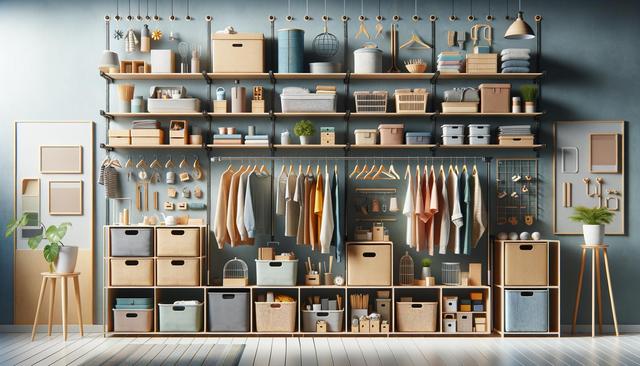Decluttering as the First Step
Before diving into specific storage solutions, it’s essential to start with decluttering. Every room in your home can benefit from a periodic review of what you own and what you no longer need. By reducing the volume of items, you create more physical and mental space, making organization more manageable. Begin with one room at a time to avoid feeling overwhelmed. In the kitchen, for example, check for expired food or duplicate utensils. In the bedroom, evaluate clothing you haven’t worn in over a year. The goal is to identify what truly adds value and eliminate what doesn’t. Once you’ve decluttered, you’ll have a clearer picture of the storage solutions that will work best for your space.
Key tips for effective decluttering include:
- Use the “keep, donate, discard” method.
- Set a timer to limit work sessions and avoid burnout.
- Be honest about what you use regularly.
- Reward yourself after completing each room.
Decluttering is the foundation of successful home organization. Without it, even the best storage systems can become overwhelmed and ineffective.
Maximizing Vertical Space
One of the most overlooked strategies in home organization is utilizing vertical space. Whether you live in a compact apartment or a spacious house, walls offer valuable real estate for storage. In the kitchen, installing open shelves can free up cabinet space while keeping frequently used items within reach. Wall-mounted racks or pegboards are excellent in garages and utility rooms for storing tools and equipment. Bedrooms and home offices also benefit from tall bookshelves or vertical organizers that make full use of wall height.
Popular vertical storage ideas include:
- Floating shelves in living rooms or bedrooms.
- Over-the-door organizers for shoes, accessories, or cleaning supplies.
- Hanging baskets in bathrooms for toiletries and towels.
- Wall hooks for coats, bags, or keys in entryways.
By thinking vertically, you not only save floor space but also enhance the visual appeal of your rooms. Vertical solutions are especially useful in smaller homes where every inch matters.
Smart Storage for Kitchens
The kitchen is one of the busiest and most used areas in any home, making efficient storage essential. To keep it organized, consider using clear containers for pantry items, which not only make contents visible but also stack neatly. Drawer dividers can separate utensils, while pull-out trays in cabinets improve access to items at the back. Lazy Susans are ideal for corners and deep shelves, and magnetic strips can hold knives or spice jars, freeing up drawer and counter space.
Additional ideas for kitchen organization:
- Label containers and bins to easily identify contents.
- Use tiered shelves for canned goods to maximize visibility.
- Install hooks under cabinets for mugs or kitchen tools.
- Keep frequently used items within arm’s reach and store seasonal or less-used appliances in higher cabinets.
By tailoring storage systems to your daily habits, you can make your kitchen both functional and pleasant to work in. Smart kitchen storage reduces time spent searching for items and makes meal prep more efficient.
Functional Bedroom and Closet Solutions
Bedrooms and closets often become catch-all spaces for miscellaneous items, clothes, and accessories. Under-bed storage is a practical solution for keeping items like shoes, linens, or out-of-season clothing out of sight but easily accessible. Closet organizers, such as hanging shelves or adjustable rods, can double your storage capacity. Drawer organizers are also useful for sorting smaller items like socks, jewelry, or ties. Consider incorporating furniture that serves dual purposes, such as storage ottomans or beds with built-in drawers.
Some effective bedroom and closet organization tips include:
- Use matching hangers to create a tidy look and save space.
- Store items in clear bins or baskets for quick identification.
- Rotate wardrobes seasonally to keep current items accessible.
- Place a hamper in the closet to encourage daily tidying.
Creating a calm and organized bedroom contributes to better rest and a more peaceful start and end to your day. Storage solutions don’t have to be expensive; even small changes can significantly improve functionality.
Organizing Living Areas and Entryways
Living rooms and entryways are high-traffic areas that benefit from thoughtful organization. Storage furniture such as coffee tables with drawers or benches with hidden compartments can keep clutter at bay. Baskets and decorative boxes are great for storing remote controls, magazines, and toys. In entryways, wall-mounted organizers or cubbies can hold shoes, bags, and mail, keeping these items from piling up on surfaces. A designated drop zone for keys and wallets also helps maintain order.
Ideas to enhance storage in these areas:
- Use a console table with storage underneath for entryways.
- Label baskets or bins for different family members or item types.
- Install a coat rack or hooks to keep jackets off furniture.
- Set up a charging station for devices to avoid tangled cords.
With the right solutions, even busy common areas can remain tidy and welcoming. Maintaining order in these spaces sets the tone for the rest of the home and makes it easier to entertain or relax with minimal effort.
Conclusion: Building an Organized Home One Room at a Time
Home organization is not a one-time task but a continuous process that evolves with your lifestyle. By focusing on practical storage solutions tailored to the needs of each room, you can create a more functional and stress-free living environment. Whether you’re starting with a single drawer or tackling an entire space, consistent effort and smart planning can lead to lasting results. Remember, organization isn’t about perfection—it’s about making your home work better for you and everyone who lives in it.




Leave a Reply